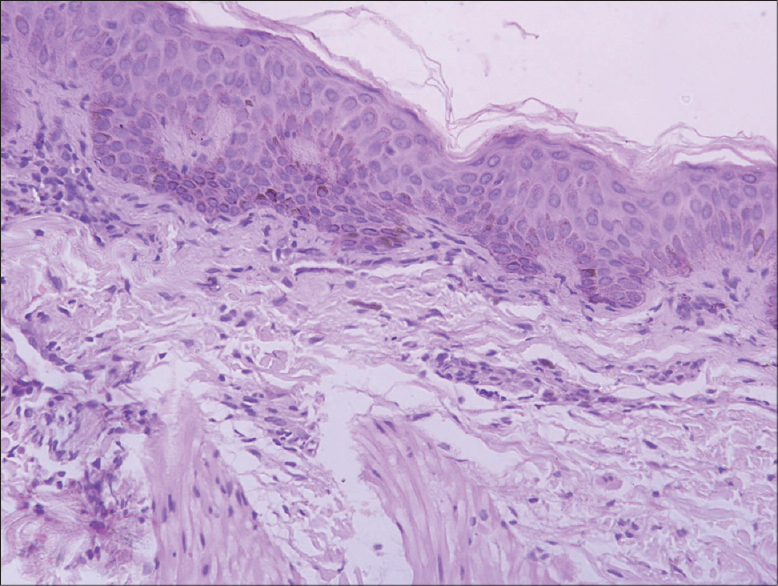Translate this page into:
Acquired linear Becker's nevus on lower limb in blaschkoid pattern
Correspondence Address:
Vineet Relhan
35-F, Sector-7, SFS Flats, Jasola Vihar, New Delhi - 110 025
India
| How to cite this article: Goel K, Relhan V, Bansal S, Garg VK. Acquired linear Becker's nevus on lower limb in blaschkoid pattern. Indian J Dermatol Venereol Leprol 2015;81:328 |
Sir,
Becker′s nevus is a relatively common cutaneous hamartoma which usually affects young males and is characterized by a unilateral hyperpigmented, hypertrichotic patch on the upper trunk or proximal upper extremities. Although usually acquired, a few congenital cases have also been reported. The lesions usually have a geographic or block-like configuration in an irregular pattern; but a linear pattern has rarely been reported in congenital cases. However, there are not many reports of acquired Becker′s nevus presenting in linear blaschkoid pattern.
A 17-year-old man presented with asymptomatic, dark brown, flat lesions over the left leg noticed 2 years. There was a concomitant increase in body hair in that region. Physical examination revealed a hyperchromic dark brown patch with irregular borders covered by dark coarse hairs extending from the left buttock up to the ankle joint, covering the posteromedial aspect of the left thigh and posterior aspect of the left leg [Figure - 1]a, b and c. The lesion had a linear distribution following the lines of Blaschko. A clinical diagnosis of Becker′s nevus was made. Thorough physical examination did not reveal any neurological or underlying musculoskeletal defect.
 |
| Figure 1: (a) Linear hyperpigmented macules with hypertrichosis on left leg extending from buttock till ankle joint; (b) linear hyperpigmented macules with hypertrichosis on left leg extending from buttock till ankle joint; (c) hyperpigmented macules with hypertrichosis on left thigh in comparison to right thigh |
Histopathological examination revealed increased pigmentation in the upper Malpighian layer, along with macrophages in the upper dermis compatible with Becker′s nevus [Figure - 2]. Routine investigations were normal. Systemic investigations including radiological examination revealed no other abnormalities.
 |
| Figure 2: Histopathologic section showing increased pigmentation in upper Malpighian layer, along with macrophages in upper dermis (H and E, original magnification ×40) |
Although in its classic form, it is considered to be an acquired disorder, congenital [1] and late onset [2] Becker′s nevus lesions have also been reported. The lesions may have various shapes but classically have a geographic or block-like configuration in an irregular fashion; however, a blaschkoid pattern or linear pattern has been reported in the literature in a few congenital cases. [1],[3] This abnormal phenotypic expression may be due to the somatic mutation occurring only in the affected segment of the body leading to linear pattern along with block configuration of some dermatoses. Blaschko′s lines represent a pattern assumed by many different nevoid and acquired skin diseases on skin and mucosa. [4] The question of whether Becker′s nevus follows Blaschko′s lines or not remains controversial. Although in 1976, Jackson listed Becker′s nevus as one of the nevoid skin diseases that follows Blaschko′s lines, [5] this fact was contradicted by Bolognia et al., who insisted that among the lesions listed by Jackson, Becker′s nevus and linear scleroderma do not follow Blaschko′s lines. [4]
Becker′s nevus has been found to be associated with chromosomal mosaicism. [6] In addition to the Blaschkoid pattern, mosaicism may produce cutaneous patterns such as checkerboard, phylloid, and patch without midline separation. Recently, Khaitan et al. reported a case of multiple Becker′s nevi with seven distinct lesions in checkerboard patterns characterized by alternating squares of hyperpigmentation with a sharp midline separation. [7]
Our patient presented with lesions in a linear distribution on the left lower limb thus following the pattern of Blaschko′s lines. However, in our case, the lesion appeared at adolescence. This was contradictory to previous reports where blaschkoid pattern of Becker′s nevus was seen only in congenital cases, It is highly likely that the tendency for its development was predetermined during embryogenesis with the formation of a clone of vulnerable cells imparting a genetic basis.
Khaitan et al. [8] reported five cases of Becker′s nevus on the lower limbs from India; all of them were of localized type. Alhausayen et al. reviewed the literature and reported 11 cases of Becker′s nevus over the lower limb, all of them being located on the proximal part of extremity (the knee and above). [9]
| 1. |
Ro YS, Ko JY. Linear congenital Becker nevus. Cutis 2005;75:122-4.
[Google Scholar]
|
| 2. |
Tymen R, Forestier JF, Boutet B, Colomb D. Late Becker's nevus: One hundred cases. Ann Dermatol Venereol 1981;108:41-6.
[Google Scholar]
|
| 3. |
Felton SJ, Al-Niaimi F, Thornton J, Lyon CC. Congenital Linear Becker's nevus, with underlying breast hypoplasia that spontaneously corrected during pregnancy: Role of androgen receptors. J Clin Trials 2012;2:4.
[Google Scholar]
|
| 4. |
Bolognia JL, Orlow SJ, Glick SA. Lines of Blaschko. J Am Acad Dermatol 1994;31:157-90.
[Google Scholar]
|
| 5. |
Jackson R. The lines of Blaschko: A review and reconsideration. Observations of the cause of certain unusual linear conditions of the skin. Br J Dermatol 1976;95:349-60.
[Google Scholar]
|
| 6. |
Lambert JR, Willems P, Abs R, Van Roy B. Becker's nevus associated with chromosomal mosaicism and congenital adrenal hyperplasia. J Am Acad Dermatol 1994;30:655-7.
[Google Scholar]
|
| 7. |
Khaitan BK, Manchanda Y, Mittal R, Singh MK. Multiple Becker's naevi: A rare presentation. Acta Derm Venereol 2001;81:374-5.
[Google Scholar]
|
| 8. |
Khaitan BK, Dogra D, Manchanda Y, Rathi S. Becker Naevus of the lower limb. Acta Derm Venereol. 1998 May; 78 (3):238-9.
[Google Scholar]
|
| 9. |
Alhusayen R, Kanigsberg N, Jackson R. Becker nevus on the lower limb: Case report and review of the literature. J Cutan Med Surg 2008;12:31-4.
[Google Scholar]
|
Fulltext Views
3,444
PDF downloads
2,167





